A User Biology Preference Prediction Model Based on the Perceptual Evaluations of Designers for Biologically Inspired Design
Abstract
1. Introduction
- What is the designer perception of animals, and what dimensions of perception do designers take inspiration from?
- What is the user preference for animals, and is there symmetry between male and female preference?
- Is there a certain mapping between user preferences and the dimensions of designer perception mentioned above?
2. Materials and Methods
2.1. Participants
- Designers: These were participants in the first part of the procedure, which was a survey of designer perception. The 18 designers invited to participate in the interview were all from China, and they included 13 senior BID designers with more than 5 years of design experience and 5 junior BID designers with 1–3 years of design experience. The designer participants included 5 graphic designers (4 senior designers) and 13 industrial designers (9 senior designers). The 124 designers invited to participate in the questionnaire were from China. All designers had certain design experience with BID (79 males and 45 females). All designers who participated in the experiment received some compensation.
- Users: These were participants in the second part of the procedure. A total of 345 people with consumption ability participated in the questionnaire survey of user preference, including 164 males and 181 females. They were all aware of the animal samples that would appear in the questionnaire and voluntarily participated in this survey.
2.2. Stimuli
2.3. Evaluation
- 1.
- Designers.
- 2.
- Users.
3. Results and Discussion
3.1. Analysis of Designer Perceptions
3.1.1. Gender Variance Analysis
3.1.2. Exploratory Factor Analysis
3.2. Analysis of User Preference
3.3. Prediction Model Establishment
4. Prediction Model Validation
5. Conclusions
Author Contributions
Funding
Conflicts of Interest
Appendix A
| it | Perception items compressed by semantic rules | Frequency |
| i1 | The animal’s appearance (whole or partial) is recognizable. | 75 |
| i2 | The animal looks cute. | 66 |
| i3 | The animal is friendly. | 47 |
| i4 | The animal has a special texture. | 38 |
| i5 | The animal is clever. | 35 |
| i6 | The animal’s color scheme is fashionable. | 33 |
| i7 | The animal looks elegant. | 31 |
| i8 | The animal is aggressive. | 31 |
| i9 | The animal is colorful. | 29 |
| i10 | The animal has a hard touch. | 27 |
| i11 | The animal has a special structure. | 25 |
| i12 | The animal is speedy. | 24 |
| i13 | The animal feels safe and reliable. | 23 |
| i14 | The animal has a round shape. | 18 |
| i15 | The animal is streamlined. | 18 |
| i16 | The animal is powerful. | 17 |
| i17 | The animal has beautiful implication. | 16 |
| i18 | The animal is majestic. | 16 |
| i19 | The animal’s color is a warning. | 15 |
| i20 | The animal’s lifestyle is leisurely. | 14 |
| i21 | The animal has rough skin. | 13 |
References
- Chen, C.H.; Chen, B.C. Friendly design and interaction relationship study on sitou tea-sipping design of cultural product. In Proceedings of the International Conference on Internationalization, Design and Global Development, Orlando, FL, USA, 9–14 July 2011; Springer: Berlin/Heidelberg, Germany, 2011; pp. 27–36. [Google Scholar] [CrossRef]
- Hargroves, K.; Smith, M. Innovation inspired by nature: Biomimicry. Ecos 2006, 129, 27–29. [Google Scholar]
- Wang, J.; Hsu, Y. The relationship of symmetry, complexity and shape in mobile interface aesthetics, form an emotional perspective—A case study of the smartwatch. Symmetry 2020, 12, 1403. [Google Scholar] [CrossRef]
- Lotfabadi, P.; Alibaba, H.Z.; Arfaei, A. Sustainability; as a combination of parametric patterns and bionic strategies. Renew. Sust. Energ. Rev. 2016, 57, 1337–1346. [Google Scholar] [CrossRef]
- Goel, A.K.; Vattam, S.; Wiltgen, B.; Helms, M. Cognitive, collaborative, conceptual and creative—Four characteristics of the next generation of knowledge-based CAD systems: A study in biologically inspired design. Comput. Aided Des. 2012, 44, 879–900. [Google Scholar] [CrossRef]
- Quinn, S.; Gaughran, W. Bionics—An inspiration for intelligent manufacturing and engineering. Robot. Comput. Integr. Manuf. 2010, 26, 616–621. [Google Scholar] [CrossRef]
- Luo, S.J.; Zhang, Y.F.; Bian, Z.; Pin, S. Status and progress of product shape bionic design. Chin. J. Mech. Eng. 2018, 54, 138–155. [Google Scholar] [CrossRef]
- Junior, W.K.; Guanabara, A.S. Methodology for product design based on the study of bionics. Mater. Des. 2005, 26, 149–155. [Google Scholar] [CrossRef]
- Emami, J.; Tashakori, M.; Tashakorinia, Z. Bionic design in Industrial Design Education at university of Tehran. In Proceedings of the DS 46: Proceedings of E&PDE 2008, the 10th International Conference on Engineering and Product Design Education, Barcelona, Spain, 4–5 September 2008. [Google Scholar]
- Mak, T.W.; Shu, L.H. Using descriptions of biological phenomena for idea generation. Res. Eng. Design 2008, 19, 21–28. [Google Scholar] [CrossRef]
- Jiang, N.; Wang, H.; Liu, H.; Hu, X.; Li, W. Application of bionic design in product form design. In Proceedings of the 2010 IEEE 11th International Conference on Computer-Aided Industrial Design & Conceptual Design, Yiwu, China, 17–19 November 2010; pp. 431–434. [Google Scholar] [CrossRef]
- Chen, W. Research on product texture bionic design and its application. Appl. Mech. Mater. 2012, 224, 212–216. [Google Scholar] [CrossRef]
- Lurie-Luke, E. Product and technology innovation: What can biomimicry inspire? Biotechnol. Adv. 2014, 32, 1494–1505. [Google Scholar] [CrossRef]
- Kim, S.J.; Lee, J.H. Parametric shape modification and application in a morphological biomimetic design. Adv. Eng. Inform. 2015, 29, 76–86. [Google Scholar] [CrossRef]
- Yeler, G.M. Creating nature awareness in design education. Procedia Soc. Behav. Sci. 2015, 174, 406–413. [Google Scholar] [CrossRef][Green Version]
- Yueneng, Y.; Xin, X.; Bin, Z.; Wei, Z.; Yidi, W. Bionic design for the aerodynamic shape of a stratospheric airship. Aerosp. Sci. Technol. 2020, 105664. [Google Scholar] [CrossRef]
- Chakrabarti, A.; Sarkar, P.; Leelavathamma, B.; Nataraju, B.S. A functional representation for aiding biomimetic and artificial inspiration of new ideas. Artif. Intell. Eng. Des. Anal. Manuf. 2005, 19, 113–132. [Google Scholar] [CrossRef]
- Nagel, J.K.; Nagel, R.L.; Stone, R.B.; McAdams, D.A. Function-based, biologically inspired concept generation. Artif. Intell. Eng. Des. Anal. Manuf. 2010, 24, 521–535. [Google Scholar] [CrossRef]
- Wilson, J.O.; Rosen, D.; Nelson, B.A.; Yen, J. The effects of biological examples in idea generation. Design Stud. 2010, 31, 169–186. [Google Scholar] [CrossRef]
- Cheong, H.; Shu, L.H. Using templates and mapping strategies to support analogical transfer in biomimetic design. Design Stud. 2013, 34, 706–728. [Google Scholar] [CrossRef]
- Deldin, J.M.; Schuknecht, M. The AskNature database: Enabling solutions in biomimetic design. In Biologically Inspired Design; Springer: London, UK, 2014; pp. 17–27. [Google Scholar] [CrossRef]
- Helfman Cohen, Y.; Reich, Y.; Greenberg, S. Biomimetics: Structure–function patterns approach. J. Mech. Des. 2014, 136. [Google Scholar] [CrossRef]
- Shu, L.H.; Cheong, H. A natural language approach to biomimetic design. In Biologically Inspired Design; Goel, A., McAdams, D., Stone, R., Eds.; Springer: London, UK, 2014; pp. 29–61. [Google Scholar] [CrossRef]
- Stone, R.B.; Goel, A.K.; McAdams, D.A. Charting a course for computer-aided bio-inspired design. In Biologically Inspired Design; Goel, A., McAdams, D., Stone, R., Eds.; Springer: London, UK, 2014; pp. 1–16. [Google Scholar] [CrossRef]
- Goel, A.; Zhang, G.; Wiltgen, B.; Zhang, Y.; Vattam, S.; Yen, J. The design study library: Compiling, analyzing and using biologically inspired design case studies. In Design Computing and Cognition’14; Springer: Cham, Switzerland, 2015; pp. 625–643. [Google Scholar] [CrossRef]
- Salgueiredo, C.F.; Hatchuel, A. Beyond analogy: A model of bioinspiration for creative design. Artif. Intell. Eng. Des. Anal. Manuf. 2016, 30, 159–170. [Google Scholar] [CrossRef]
- Vandevenne, D.; Pieters, T.; Duflou, J.R. Enhancing novelty with knowledge-based support for biologically-inspired design. Design Stud. 2016, 46, 152–173. [Google Scholar] [CrossRef]
- Cheong, H.; Shu, L.H. Effective analogical transfer using biological descriptions retrieved with functional and biologically meaningful keywords. In Proceedings of the ASME 2009 International Design Engineering Technical Conferences and Computers and Information in Engineering Conference, San Diego, CA, USA, 30 August–2 September 2009; American Society of Mechanical Engineers Digital Collection. pp. 763–773. [Google Scholar] [CrossRef]
- Yargın, G.T.; Firth, R.M.; Crilly, N. User requirements for analogical design support tools: Learning from practitioners of bio-inspired design. Design Stud. 2018, 58, 1–35. [Google Scholar] [CrossRef]
- Hsu, S.H.; Chuang, M.C.; Chang, C.C. A semantic differential study of designers’ and users’ product form perception. Int. J. Ind. Ergon. 2000, 25, S0169–S814100026. [Google Scholar] [CrossRef]
- Park, S.; Choi, D.; Kim, J. Critical factors for the aesthetic fidelity of web pages: Empirical studies with professional web designers and users. Interact. Comput. 2004, 16, 351–376. [Google Scholar] [CrossRef]
- Chevalier, A.; Kicka, M. Web designers and web users: Influence of the ergonomic quality of the web site on the information search. Int. J. Hum. Comput. Stud. 2006, 64, 1031–1048. [Google Scholar] [CrossRef]
- Ng, A.W.; Chan, A.H. Color associations among designers and non-designers for common warning and operation concepts. Appl. Ergon. 2018, 70, 18–25. [Google Scholar] [CrossRef]
- Slovic, P. The construction of preference. Am. Psychol. 1995, 50, 364. [Google Scholar] [CrossRef]
- Berkowitz, M. The influence of shape on product preferences. ACR N. Am. Adv. 1987, 14, 559. [Google Scholar]
- Huang, Y.; Qian, L. Consumer preferences for electric vehicles in lower tier cities of China: Evidences from south Jiangsu region. Transp. Res. Part D Transp. Environ. 2018, 482–497. [Google Scholar] [CrossRef]
- Ma, S.C.; Fan, Y.; Guo, J.F.; Xu, J.H.; Zhu, J.N. Analysing online behaviour to determine Chinese consumers’ preferences for electric vehicles. J. Clean Prod. 2019, 229, 244–255. [Google Scholar] [CrossRef]
- Viciunaite, V.; Alfnes, F. Informing sustainable business models with a consumer preference perspective. J. Clean Prod. 2020, 242, 118417. [Google Scholar] [CrossRef]
- Maeng, K.; Kim, J.; Shin, J. Demand forecasting for the 5G service market considering consumer preference and purchase delay behavior. Telemat. Inform. 2020, 47, 101327. [Google Scholar] [CrossRef]
- De Angelis, M.; Stuiver, A.; Fraboni, F. Green wave for cyclists: Users’ perception and preferences. Appl. Ergon. 2019, 76, 113–121. [Google Scholar] [CrossRef] [PubMed]
- Kim, S.H. Choice model based analysis of consumer preference for drone delivery service. J. Air Transp. Manag. 2020, 84, 101785. [Google Scholar] [CrossRef]
- Murphy, S.; Charokarisa, H.; Rajaratnam, S. Selective breeding trait preferences for farmed tilapia among low-income women and men consumers in Egypt: Implications for pro-poor and gender-responsive fish breeding programmes. Aquaculture 2020, 525, 735042. [Google Scholar] [CrossRef]
- Chai, C.; Bao, D.; Sun, L. The relative effects of different dimensions of traditional cultural elements on customer product satisfaction. Int. J. Ind. Ergon. 2015, 48, 77–88. [Google Scholar] [CrossRef]
- Renaud, J.; Houssin, R.; Gardoni, M. Product manual elaboration in product design phases: Behavioral and functional analysis based on user experience. Int. J. Ind. Ergon. 2019, 71, 75–83. [Google Scholar] [CrossRef]
- Damodaran, L. User involvement in the system design process-a practical guide for users. Behav. Inf. Technol. 1996, 15, 363–377. [Google Scholar] [CrossRef]
- Heller, F.; Pusic, E.; Strauss, G. Organizational Participation: Myth and Reality; Oxford University Press: Oxfordshire, UK, 1998. [Google Scholar]
- Mieczakowski, A.; Langdon, P.; Clarkson, P.J. Investigating designers’ and users’ cognitive representations of products to assist inclusive interaction design. Univers. Access Inf. Soc. 2013, 12, 279–296. [Google Scholar] [CrossRef]
- Khalaj, J.; Pedgley, O. A semantic discontinuity detection (SDD) method for comparing designers’ product expressions with users’ product impressions. Design Stud. 2019, 62, 36–67. [Google Scholar] [CrossRef]
- Marshall, R.; Cook, S.; Mitchell, V. Design and evaluation: End users, user datasets and personas. Appl. Ergon. 2015, 46, 311–317. [Google Scholar] [CrossRef][Green Version]
- Eckert, C.; Stacey, M. Sources of inspiration: A language of design. Design Stud. 2000, 21, S0142–S0694. [Google Scholar] [CrossRef]
- Chang, H.C.; Lai, H.H.; Chang, Y.M. A measurement scale for evaluating the attractiveness of a passenger car form aimed at young consumers. Int. J. Ind. Ergon. 2007, 37, 21–30. [Google Scholar] [CrossRef]
- Tinsley, H.E.; Tinsley, D.J. Uses of factor analysis in counseling psychology research. J. Couns. Psychol. 1987, 34, 414. [Google Scholar] [CrossRef]
- Likert, R. A technique for the measurement of attitudes. Arch. Psychol. 1932, 22, 1–55. [Google Scholar]
- Hsu, C.C.; Fann, S.C.; Chuang, M.C. Relationship between eye fixation patterns and Kansei evaluation of 3D chair forms. Displays 2017, 50, 21–34. [Google Scholar] [CrossRef]
- Misaka, M.; Aoyama, H. Development of design system for crack patterns on cup surface based on KANSEI. J. Comput. Des. Eng. 2018, 5, 435–441. [Google Scholar] [CrossRef]
- Zou, Y.; Wang, Z. Subjective Product Evaluation System Based on Kansei Engineering and Analytic Hierarchy Process. Symmetry 2020, 12, 1340. [Google Scholar]
- Quan, H.; Li, S.; Wei, H.; Hu, J. Personalized Product Evaluation Based on GRA-TOPSIS and Kansei Engineering. Symmetry 2019, 11, 867. [Google Scholar] [CrossRef]
- Hair, J.F.; Black, W.C.; Babin, B.J.; Anderson, R.E.; Tatham, R.L. Multivariate Data Analysis; Prentice Hall: Upper Saddle River, NJ, USA, 1998; Volume 5, pp. 207–219. [Google Scholar]
- DeVellis, R.F. Scale Development: Theory and Applications; Sage: Newbury Park, CA, USA, 1991. [Google Scholar]
- Shen, H.C.; Wang, K.C. Affective product form design using fuzzy Kansei engineering and creativity. J. Ambient Intell. Humaniz. Comput. 2016, 7, 875–888. [Google Scholar] [CrossRef]
- Tonetto, L.M.; Desmet, P.M.A. Why we love or hate our cars: A qualitative approach to the development of a quantitative user experience survey. Appl. Ergon. 2016, 56, 68–74. [Google Scholar] [CrossRef]


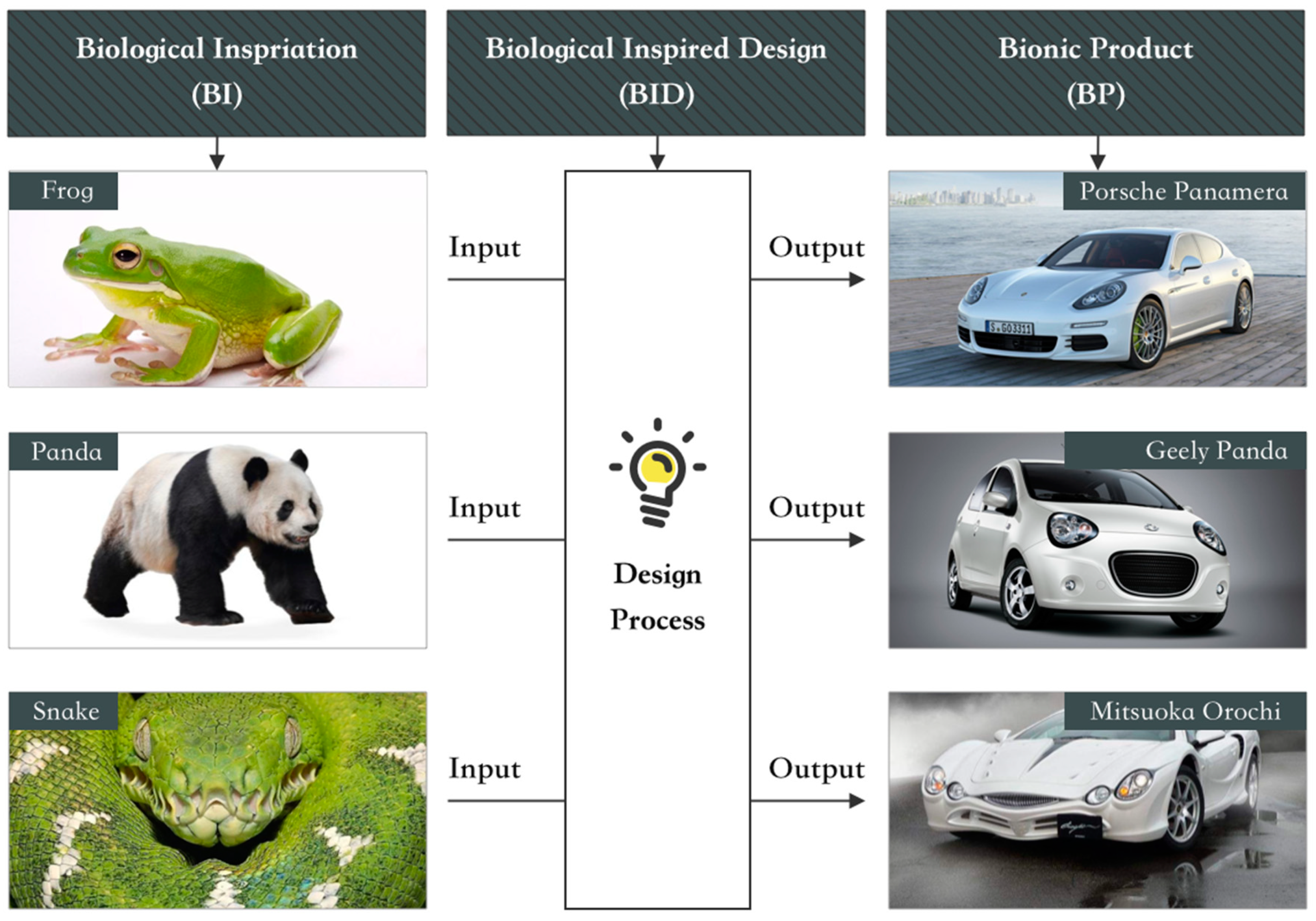
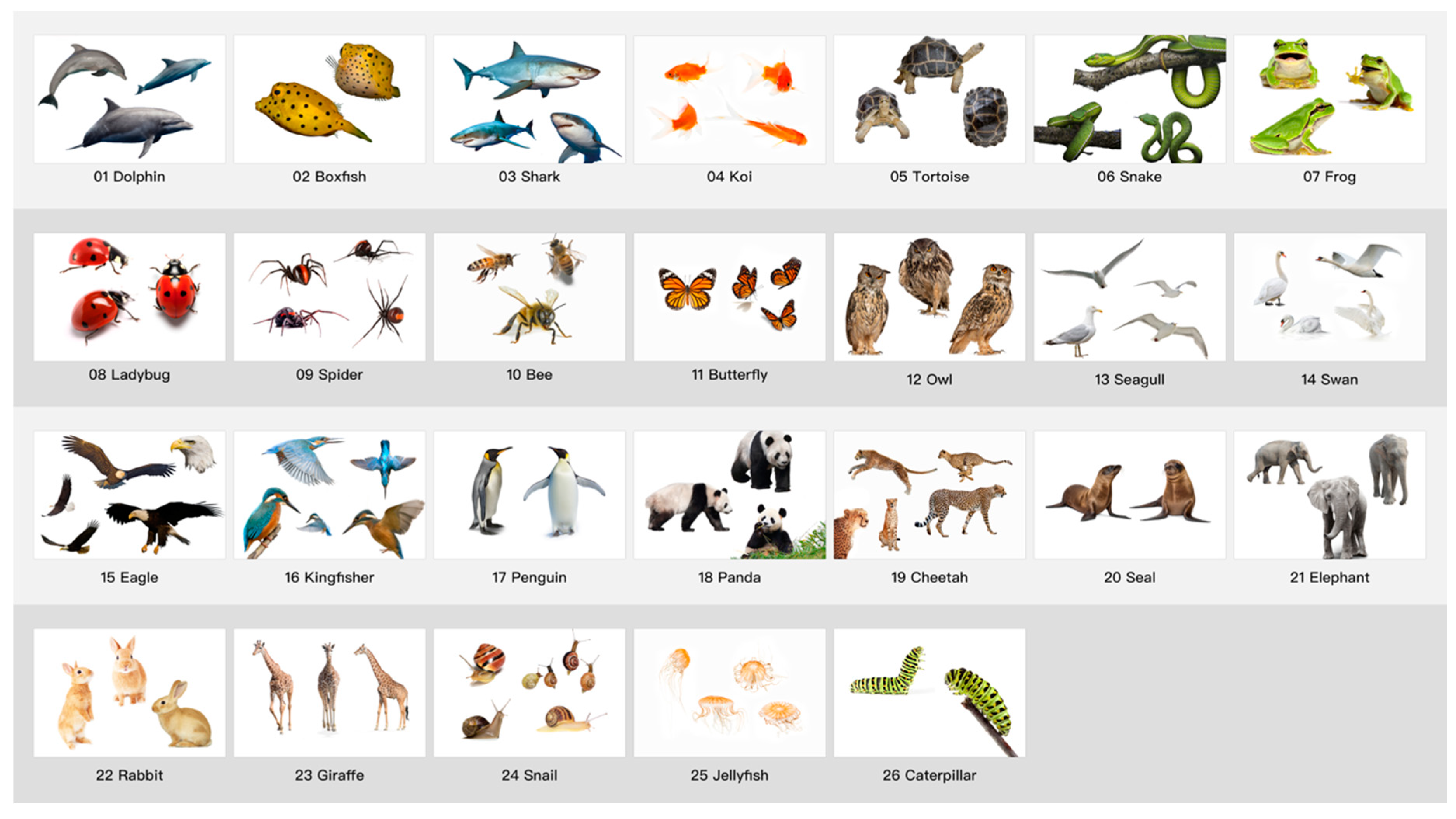
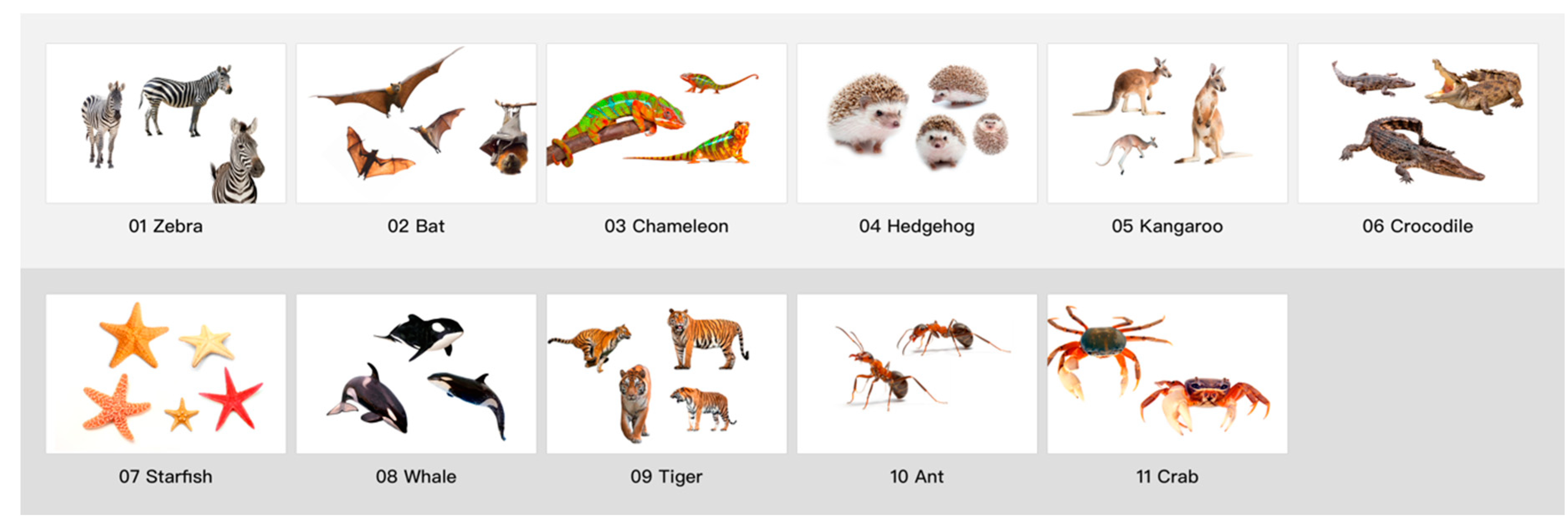
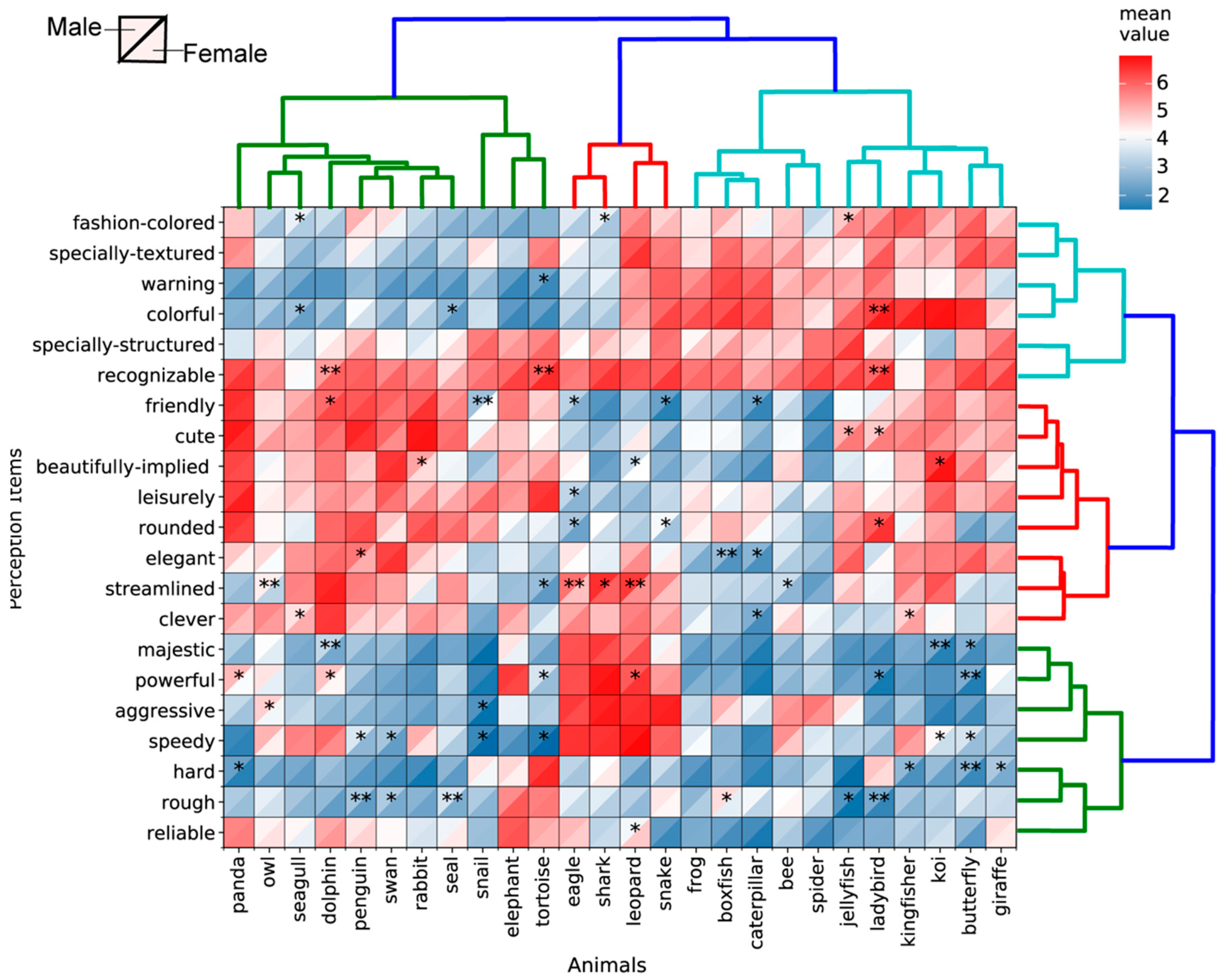
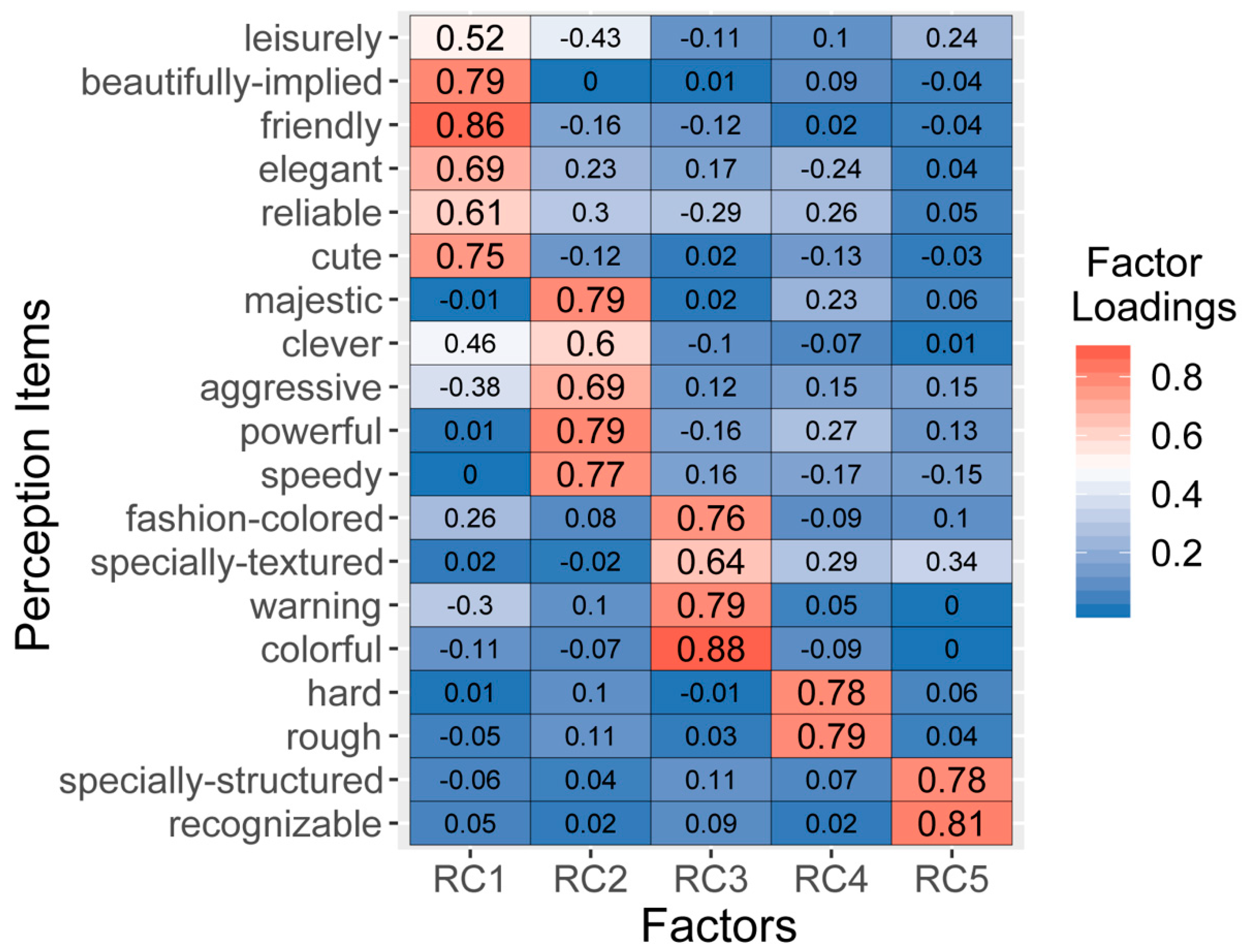
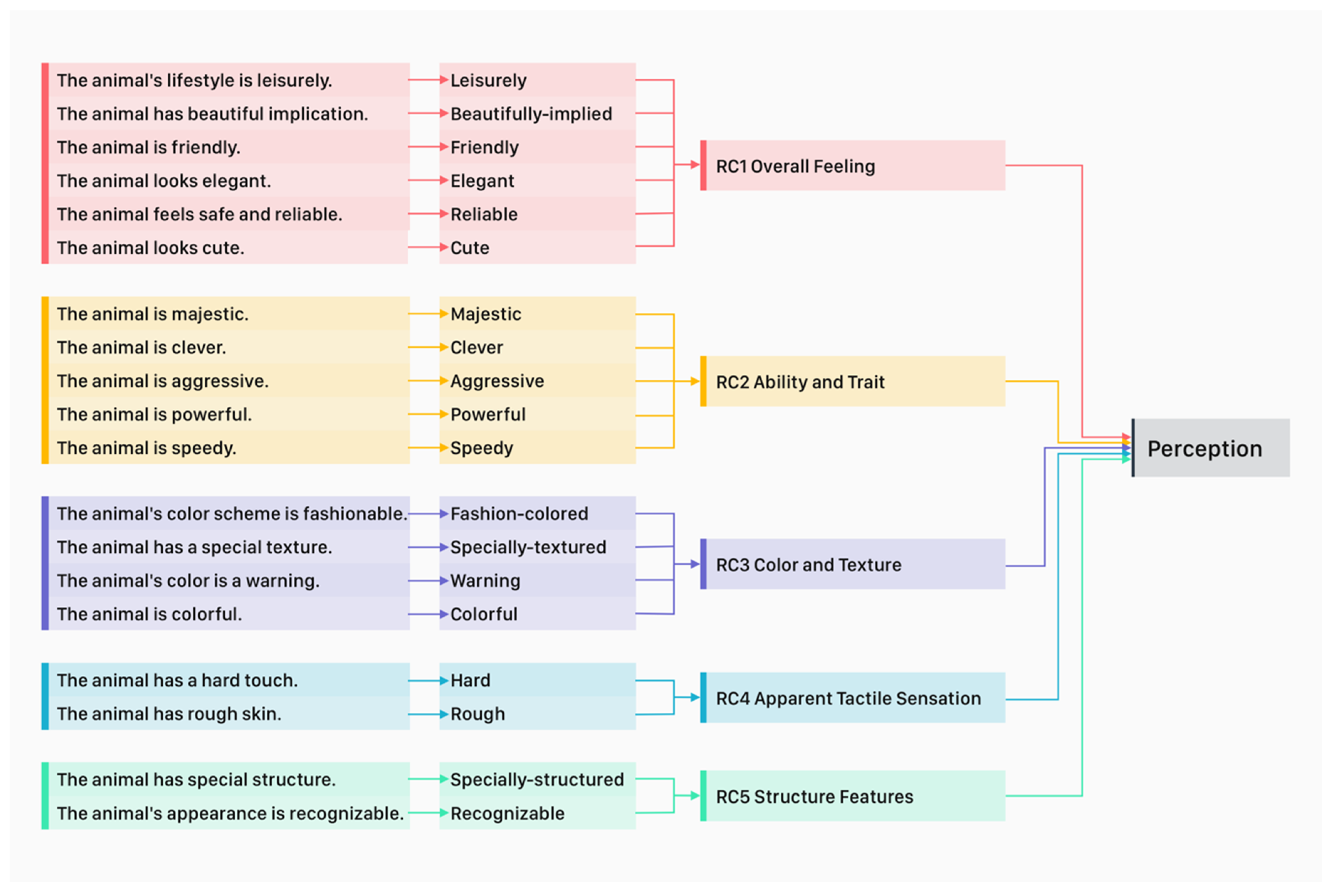
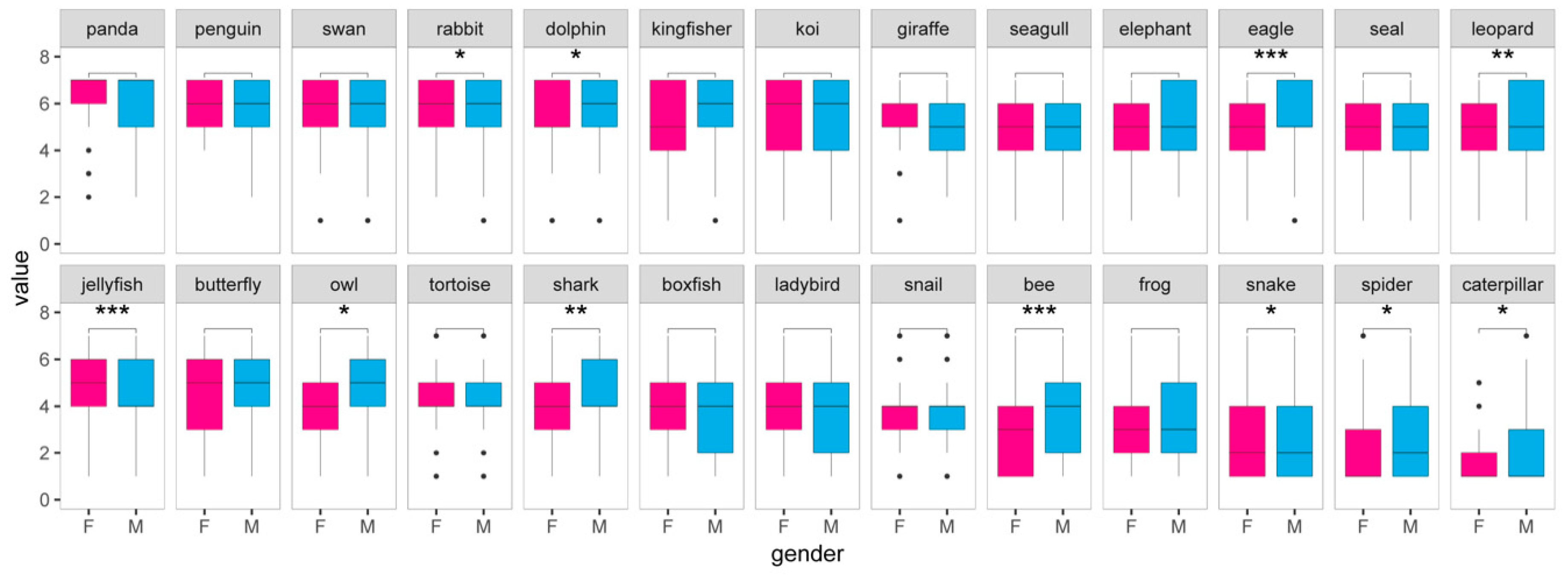
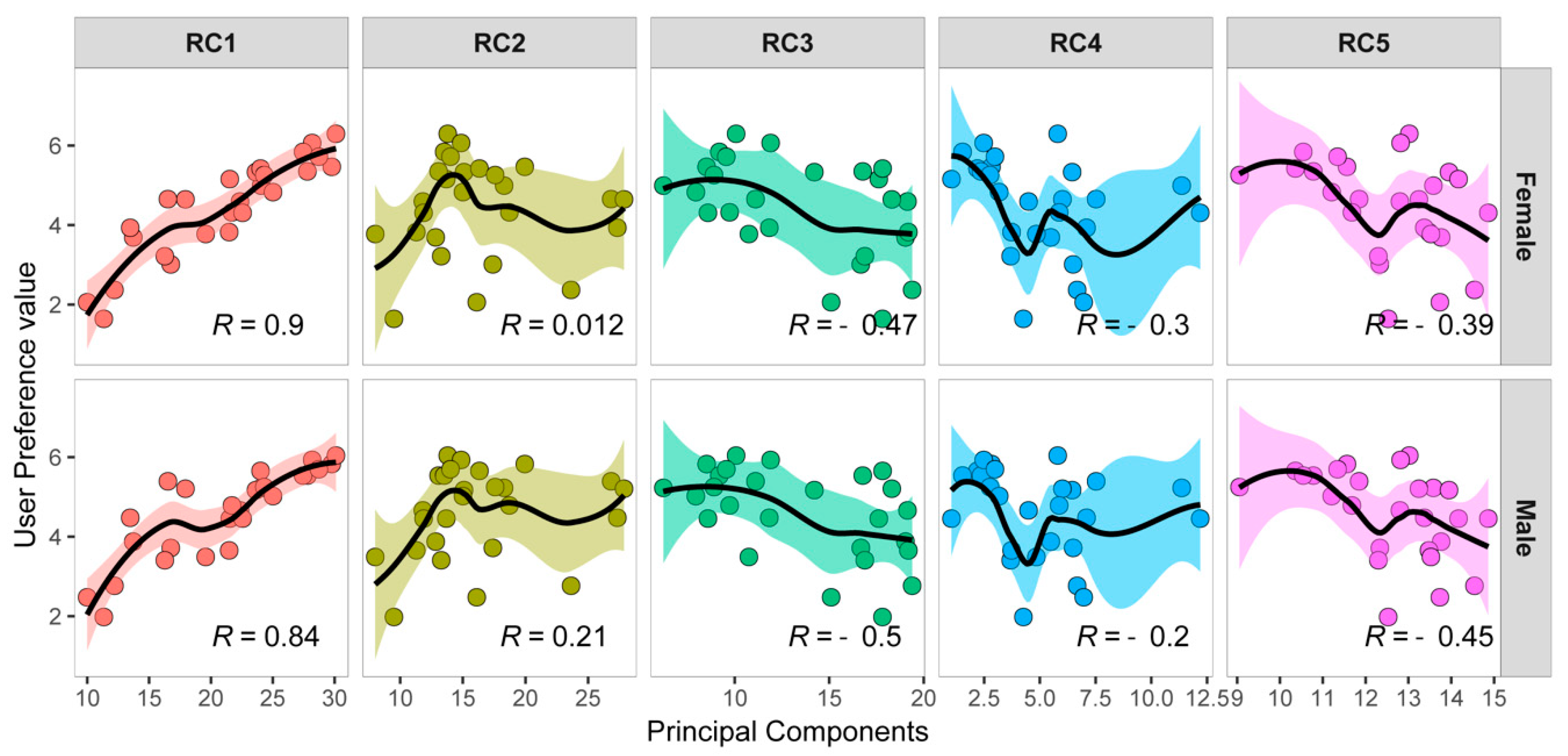
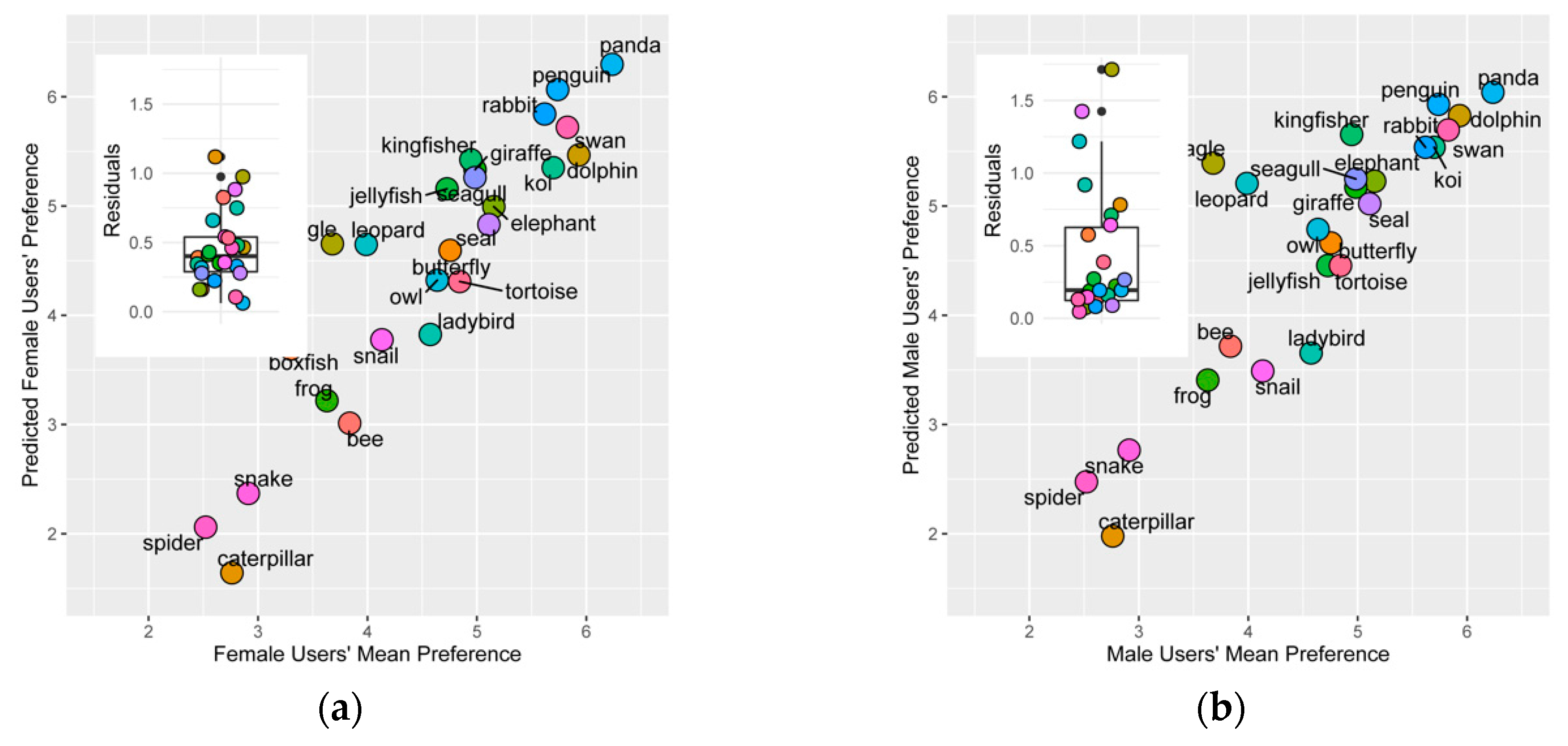
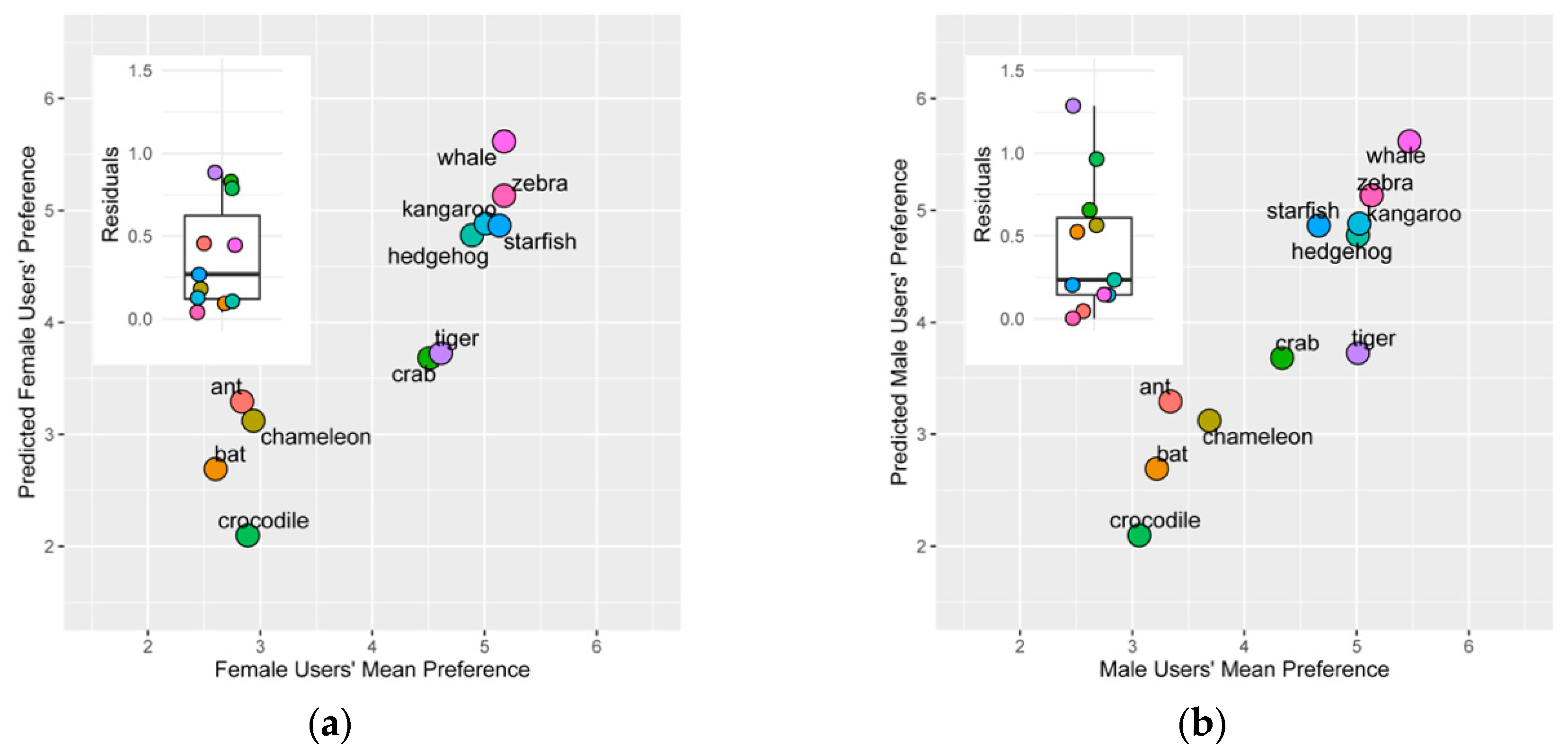
Publisher’s Note: MDPI stays neutral with regard to jurisdictional claims in published maps and institutional affiliations. |
© 2020 by the authors. Licensee MDPI, Basel, Switzerland. This article is an open access article distributed under the terms and conditions of the Creative Commons Attribution (CC BY) license (http://creativecommons.org/licenses/by/4.0/).
Share and Cite
Luo, S.; Zhang, Y.; Zhang, J.; Xu, J. A User Biology Preference Prediction Model Based on the Perceptual Evaluations of Designers for Biologically Inspired Design. Symmetry 2020, 12, 1860. https://doi.org/10.3390/sym12111860
Luo S, Zhang Y, Zhang J, Xu J. A User Biology Preference Prediction Model Based on the Perceptual Evaluations of Designers for Biologically Inspired Design. Symmetry. 2020; 12(11):1860. https://doi.org/10.3390/sym12111860
Chicago/Turabian StyleLuo, Shijian, Yufei Zhang, Jie Zhang, and Junheng Xu. 2020. "A User Biology Preference Prediction Model Based on the Perceptual Evaluations of Designers for Biologically Inspired Design" Symmetry 12, no. 11: 1860. https://doi.org/10.3390/sym12111860
APA StyleLuo, S., Zhang, Y., Zhang, J., & Xu, J. (2020). A User Biology Preference Prediction Model Based on the Perceptual Evaluations of Designers for Biologically Inspired Design. Symmetry, 12(11), 1860. https://doi.org/10.3390/sym12111860





